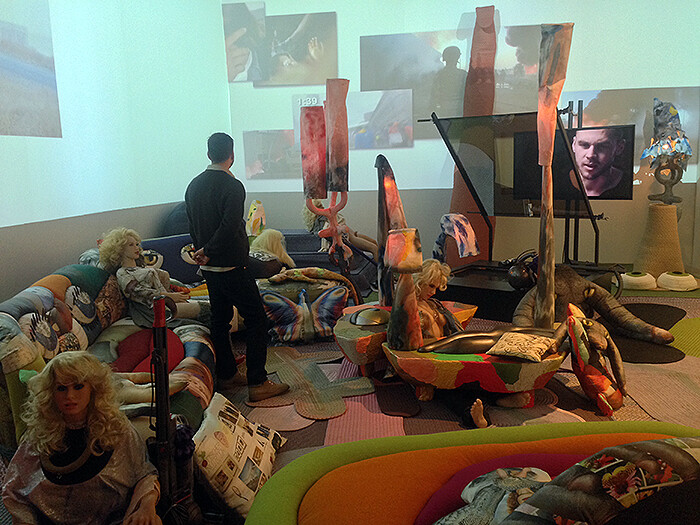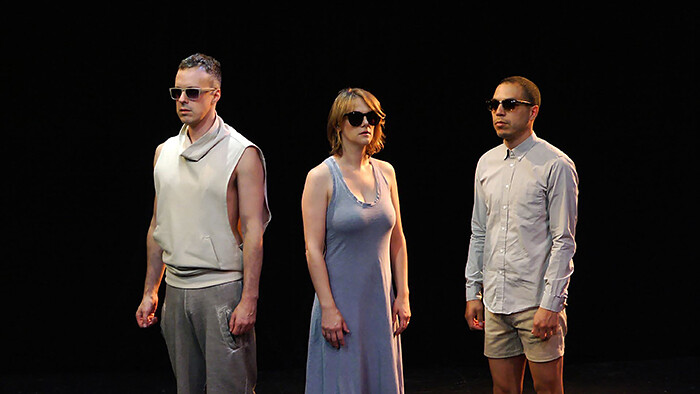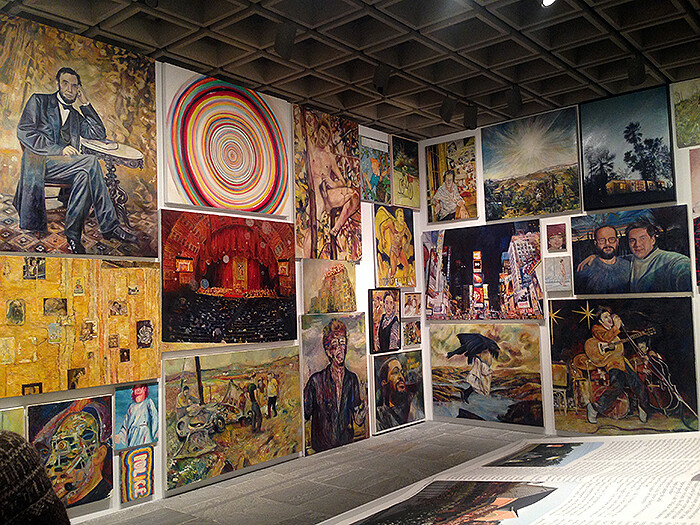The most streamlined mythology of the past two decades of the Whitney Biennial goes something like this: 1993 represented the Big Bang of art and identity politics, and since then, the curve has bobbed up and down like a sine wave, going above and below the axis of overthought mediocrity towards an ever more platitudinous parody of itself. It is, after all, the biennial that everyone… loves to hate. Shoot me now. Framing it this way can be as mind numbing as discussing the weather, and yet, it is nearly as inescapable.
Perhaps drawing from its upper Manhattan terroir, the Whitney Biennial is an inimitable, enduringly anachronistic, and extremely self-referential institution. Each edition rehashes the questions “What is contemporary?” and “What is American?”—often to post-rational ends. Convoluted curatorial conceit is the most dangerous pitfall threatening state-of-the-art-world survey shows today. The best biennial I’ve seen in the past couple of years was Luiz Pérez-Oramas, André Severo, and Tobi Maier’s 2012 30th São Paulo Biennial about, simply, “poetics”—a theme so loose and extensible that the exhibition wore it as a heartening halo rather than a pretentious noose. In this respect, the 2014 Whitney Biennial does not fail. Well, actually, it does, but only in execution; the conception of its structure and thematics do not doom or significantly distract from the works contained therein. Assembled by three outside curators—Stuart Comer of New York’s Museum of Modern Art, Anthony Elms of the Institute of Contemporary Art in Philadelphia, and Michelle Grabner of the School of the Art Institute of Chicago—it is not rhetorically proposed as three discrete shows; it is actually (actuality is always refreshing!) three discrete shows spread across three levels of the Whitney Museum’s 945 Madison Avenue building.
The second floor, curated by Elms, is exhaustingly under-stimulating. On first glance, Valerie Snobeck and Catherine Sullivan’s Image of Limited Good (2014), a sculptural tableau of suitcases filled with a resin-like substance and purple tracings of retro airline logos pinned to the wall, looks promising, but—pardon the pun—unpacking the piece is a joyless pursuit. It would work better at an art fair, as would Charline von Heyl’s Folk Tales (2013), a grid of black-and-white collages, which is not awkward like some of the other works on this floor, but by no means as absorbing as her work usually is. Transgressive hero Gary Indiana’s untitled contribution seems dated and confused. It’s comprised of a diptych pairing a collection of headshots and nude candid photographs of incarcerated men of color with a large, inelegantly installed, semi-circular LED curtain looping footage of jellyfish, which, according to the text, are anatomically symbolic of… the panopticon. The effect of the piece is incomprehensible (in this room it might not actually be possible to get far enough away from the curtain to view its moving images as such, instead of as a crumpled field of large diodes); it superficially juxtaposes cultural issues from the 1980s with presentation technologies that are modern, but look terrible. Rebecca Morris’s paintings, Untitled (#14-13) (2013) and Untitled (#15-13) (2013), given the company, stand out, and respite can also be found in the two cinemas made to house films by Michel Auder, Steve Reinke with Jessie Mott, and the Los Angeles-based collective My Barbarian, but in terms of this chapter of the Biennial having a compelling story or discernable position, there is none.
Moving up one level and several notches in quality, Comer’s third floor contains the highest concentration of expected names. This is by no means a dig: why not represent the most consistent and influential American artists in the Whitney Biennial, particularly if they haven’t been invited before? At the pinnacle of buzzy and undeniably good is the singular and prolific force that is Bjarne Melgaard. His room recalls the Korova Milk Bar (from A Clockwork Orange), populated by silicon sex mannequins with blond weaves and raccoon eyes, posed alternately on haute, club kid furniture you might find in a fancy, edgy French person’s apartment and on the wholesome braided carpets you might find in a Maine farmhouse. The Gesamkunstwerk, entitled Think I’m Gonna Have A Baby (2014), includes projections of found clips depicting interchangeable violence between animals and people respectively, and a monitor with a staged, raunchy confessional dialogue between two gay lovers who seem to hate one another. The wall text identifies the dissolution of humanity into a circus of cruelty as its subject, but this declaration is, frankly, not even necessary, because the work is writ so large, scary, and engrossing.
Shaped like the islands of Manhattan, Hawaii, and Kauai, Ei Arakawa’s hats for two and three people, are, by contrast, totally benign, but much crazier. Arakawa’s mutable and often inscrutable practice has been hitting for a while now—another New York-based artist, like Melgaard, whose industrious imagination has flourished during the past years in a corporatized city that has been sapped of its creative life force. It’s not immediately clear if Ken Okiishi’s vertical, wall-mounted flatscreens, each titled gesture/data (2013), partially painted over with impressionistic brushstrokes are important, but they look fresh; and the floor-to-ceiling salon hanging of Keith Mayerson paintings, casting autobiographical moments alongside renditions of iconic American people and symbols, gives the underappreciated painter his due. On a different register, a room near the back of floor three—Afterlife: a constellation (2014), organized as a work of art, at Comer’s invitation, by Group Material cofounder Julie Ault—interweaves intergenerational referents and inspirations into a tautology unbound by the unities of time and place. To name but a few, filmmaker Matt Wolf’s slideshow, which includes a narration that touches on his adolescent discovery of the late David Wojnarowicz, is placed next to Wojnarowicz’s own Calendar (1989). To its left is Closed (1984–85), a painting by late Lower East Side artist Martin Wong, who is an ongoing subject of inquiry for Danh Vo. And in turn, Vo’s piece, snowfall/northern Sierras 1847 (2013), which echoes Alfred A. Hart’s photograph Stumps cut by Donner Party (c. 1868), is placed on the other side of the room near a text by Ault about Wong and Wojnarowicz. But the most transcendent inclusion on this floor has got to be Lebanese-born Etel Adnan, the eighty-nine-year-old writer, poet, and here, painter, whose canvases depict emotional landscapes told in simple compositions of four or five hard-edged hues, and whose two epic poems outstretched in accordion books go from earth to space to death to life and back in an unbroken, linear circle.
None of the three shows are sparse, but Grabner’s fourth floor jams the most works in of all. Even more so than in Comer’s exhibition, the two most captivating works are made by popular, market-anointed artists. Sterling Ruby, working in his best medium—ceramics— puts forth three Vulcan maws from his “Basin Theology” series (2013–14), full of glossy, broken archaeologies. Behind those is one big painting, As-yet-untitled (2014) by Laura Owens, which both eschews verbal description and has a lot of fun with words; the text “When you come to the end of your rope, make a knot, and hang on” accompanies a 1980s children’s illustration of a boy and his dog swinging by rope across a teal void, within and beneath a meticulously layered vortex of painting posing as digital effects, posing as painting. Many other big, colorful, abstract paintings by women fill this main room: Jacqueline Humphries, Louise Fishman, Molly Zuckerman-Hartung, Dona Nelson, and Amy Sillman. The largest canvas, Gaylen Gerber’s undated Backdrop/Untitled, is flat grey and inconspicuously stretched around the entire wall outside the elevator. It is itself a surface for other works to be hung on; presently it’s Trevor Shimizu’s untitled ritualistic figurative compositions but on April 15, as the wall label tells us, it will be replaced by Sherrie Levine’s Thin Stripe: 10 (1986) and David Hammons’s Untitled (2010). Placed at the end of the most natural path through the fourth floor, Zoe Leonard’s 945 Madison Avenue (2014) is all about depriving the viewer of light. It’s a huge camera obscura refracting the quotidian windows of Madison Avenue onto its walls. As an elegy to the building on the occasion of its last biennial, it’s a much too obvious, precious note to end on—something that could have been devised by a PR assistant as readily as by a great photographer like Leonard. Overall, there is a bit too much going on here for Grabner’s show to coalesce a striking identity, but there’s a harmonious enough fluidity to how it all intermingles, probably owing to the personal and pedagogical connections among the artists and to the curator, who is an artist herself.
Something about that lends itself to the overarching Biennial’s greatest success, whose most contemporary experiment deals with framing a curator as a locus of collaborations and conversations, rather than the steward of conceptual frameworks that enslave art. Grabner’s show is not about the Midwest, but there is a preponderance of artists from Chicago and the surrounding region (even a Dawoud Bey photographic portrait of the Chicagoan American president, Barack Obama (2008), is hung above her curatorial statement). Comer’s exhibition doesn’t stake itself as a queer show, and by no means exclusively contains queer artists, but he and most of the ones that I was struck by and mentioned above publicly identify as queer (as do I). Perhaps Elms’s show suffers because it lacks an expansive, lived impetus. But ultimately, at the risk of being boring, I must conclude the same as usual… the Biennial essentially falls flat. Though multifaceted, it’s hard to imagine a truly textured object with only three sides. That the three exhibitions fully commit to their autonomy is a good thing, but unfortunately, the aggregate effect that arises from their congress feels jumbled and piecemeal. The experiment as a whole fails, and while it shouldn’t go in the vault as our recollection of 2014, it is a step forward because, suspended in the loftiest, Sisyphean heights of democratized irreality, testing its own form is exactly what the Whitney Biennial should always endeavor to do.












